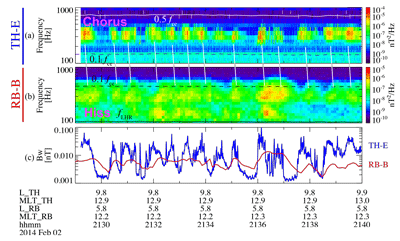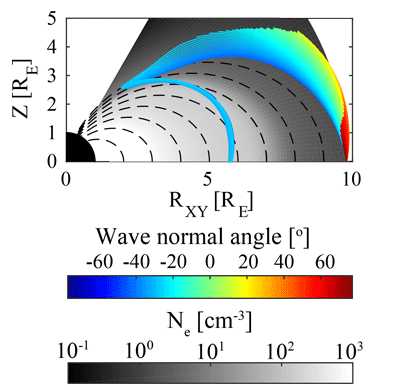
2015 THEMIS SCIENCE NUGGETS
First Evidence for Chorus at a Large Geocentric Distance as a Source of Plasmaspheric Hiss: Coordinated THEMIS and Van Allen Probes Observation
by Wen Li
UCLA Atmospheric & Oceanic Sciences
Introduction
Plasmaspheric hiss is a broadband incoherent whistler-mode emission observed predominantly in the plasmasphere or high-density plumes. Since its discovery in the 1960s, hiss emissions have been shown to effectively scatter energetic electrons over various energies, and thus play an important role in controlling the overall structure and dynamics of the Earth’s radiation belts.
Despite its importance, the elusive origin of hiss has been a topic of intense debate for over four decades. A recent planned coordination campaign between THEMIS and Van Allen Probes on the dayside provided an unprecedented opportunity to capture chorus and hiss simultaneously. We report a particularly interesting event exhibiting a remarkable correlation between chorus and hiss, which we interpret as causal.
| Figure 1. (a) Frequency-time spectrogram of magnetic spectral density from TH-E. (b) Frequency-time spectrogram of magnetic spectral density from RB-B. The white or black lines in Figures 1a and 1b represent 0.5 fce, 0.1 fce, and fLHR. (c) Wave amplitudes integrated over 200-600 Hz observed on TH-E (blue) and RB-B (red). |
Results
Figure 1 shows the coordinated wave observation between THEMIS E (TH-E) and Van Allen Probe B (RB-B). TH-E was located at 9.8 RE and ~12.9 MLT, and observed modulated whistler-mode chorus waves (Figure 1a) outside the plasmapause. Interestingly, during the same period RB-B detected hiss wave modulation at ~5.8 RE inside the plasmasphere at a slightly earlier MLT (~12.2 h). As shown in Figure 1c, the comparison of chorus and hiss wave amplitudes integrated over 200-600 Hz observed by TH-E and RB-B exhibits an excellent correlation but with a time delay of 5-8 s. We also calculated correction coefficients between two wave spectra, and found that the highest correlation > ~0.7 was obtained in the frequency range of 225-350 Hz with a time lag of ~5-8 s. Because the chorus modulation precedes hiss modulation by ~5-8 s, these observations suggest that hiss may originate from chorus and the propagation time from the chorus source region to the observed location of hiss is ~5-8 s.
| Figure 2.The evolution of ray path in the meridional plane launched with various wave normal angles (color-coded). The latitudinal distribution of plasma density is shown with the gray color bar and the black dashed line represents the dipole magnetic field line. |
To evaluate whether the aforementioned time delay is consistent with chorus being the embryonic source of hiss, we performed a 2-D ray tracing simulation using the HOTRAY code. The ray tracing results for a wave frequency of 300 Hz are shown in Figure 2, where the plasma density distribution in the meridional plane is shown in a gray color bar together with the ray trajectories color-coded for rays launched with various initial wave normal angles. These rays were initially launched at 9.8 RE at the magnetic equator, where chorus waves were observed by TH-E, and subsequently propagated towards higher latitudes. As shown in Figure 2, the rays with wave normal angles between -41° and -26° can enter into the plasmasphere, experience internal reflection and subsequently propagate toward the equator crossing the L ~ 5.6-5.8, very close to the region where RB-B observed hiss. The propagation time for this group of rays from the chorus source region at the L-shell of 9.8 to the magnetic equator is about 5-6 s, which is in excellent agreement with the observed time delay where the highest correlation was obtained.
Conclusion
Using a coordinated observation from THEMIS and Van Allen Probes, we report a particularly interesting event, where plasmaspheric hiss appeared to originate from modulated chorus waves at large L-shells (~9.8), different from the previously reported events observed at smaller L-shells (< 6). The chorus waves were observed at a large L-shell of ~9.8, which is surprising because previous modeling suggested that chorus should be unable to propagate into the plasmasphere from such large distances without being severely Landau damped. Our ray tracing simulation supports our assertion and explains why chorus observed at such a large L-shell can propagate into the plasmasphere and contribute to hiss formation.
Reference
Li, W., L. Chen, J. Bortnik, R. M. Thorne, V. Angelopoulos, C. A. Kletzing, W. S. Kurth, and G. B. Hospodarsky (2015), First evidence for chorus at a large geocentric distance as a source of plasmaspheric hiss: Coordinated THEMIS and Van Allen Probes observation, Geophys. Res. Lett., 42, 241–248, doi:10.1002/2014GL062832.Biographical Note
Wen Li is a research scientist in the Department of Atmospheric and Oceanic Sciences at UCLA.
 Please send comments/suggestions to
Emmanuel Masongsong / emasongsong @ igpp.ucla.edu
Please send comments/suggestions to
Emmanuel Masongsong / emasongsong @ igpp.ucla.edu


